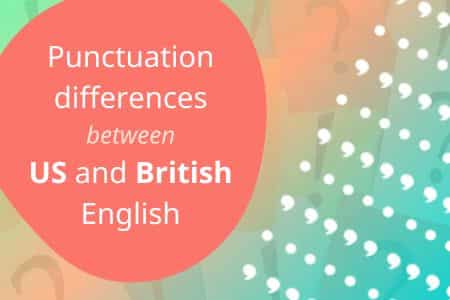One question the translators on our courses regularly ask is what are the punctuation differences between US and British English? I researched this in detail when writing The Translator’s Studio’s punctuation course Punctuation Pro. So, here’s an overview of some of the main differences in punctuation between these two wonderful versions of the English language.
Wondering what punctuation books I use? Check out my best punctuation books.

1. Use of the serial comma
The serial comma is also known as the Oxford comma, the Harvard comma, and the series comma.
It’s used in lists of three or more items and is placed before the last item in the list.
The general rule with the serial comma is that if you’re writing in US English, you should use it. But if you’re writing in British English, you shouldn’t.
If you want to see an example of the serial comma in use, re-read the opening line of this section. Even though I’m British, I’ve used the serial comma. This is typically wrong in British English, except in Oxford Style.
Some British clients prefer to follow Oxford style. If they ask you to follow it, then you should use the serial comma. Also, you sometimes need the serial comma to avoid ambiguity. Conversely, you sometimes have to remove it because it creates ambiguity.
In short, like with many “rules”, the writer will sometimes need to override this one.
2. Double or single quotation marks?
It’s generally agreed that writers working in US English should use double quotation marks and that writers working in British English should use single quotation marks.
But this isn’t necessarily a US–British thing. In reality, different publishers follow different rules.
For instance, news outlets that use British English tend to use double quotation marks. In fact, I prefer double quotation marks on this blog. I just think they look better.
When you’re working for a client, find out their preferences and follow them. If you’re doing your own thing, feel free to choose the option you prefer.
3. Parentheses v. brackets
American writing nerds will spend all day at an independent bookstore café discussing the use of the parenthesis (plural form parentheses). Across the pond, British writing nerds do the same thing except they’re talking to their friends about brackets. Both of these types of nerds are referring to the curved punctuation mark that looks like this: ().
What the British call square brackets are referred to in US English as brackets.
Well, I never!

4. Formatting of parenthetical dashes in US and UK English
It’s generally agreed that the unspaced em dash is more typical of US English and that the spaced en dash is more typical of British English, but there are notable exceptions, like Oxford again.
If you’re working for a client, either check their preferences or consider making the US/British English differentiation I just mentioned. If you’re doing your own thing, make sure you’re consistent across any given text.
5. Differences in date formatting between American and British English
Standard date layout across many publications is 7 July (British English) and July 7 (US English). If you add the year then it would be 7 July 2011 (British) and July 7, 2011 (US). This is what I recommend our students do because it’s backed up by a host of authorities such as Chicago, Oxford, and the EU.
You’ll find other formats in style guides, and perhaps you like faffing about with th and nd because you think it looks better. Using these formats is correct English. So, you can do it unless the client requests an alternative style.
I hope you enjoyed this taste of some of the punctuation research that went into producing the Punctuation Pro course for The Translator’s Studio. It’s a fun, 30-day course where you’ll go step by step through the world of punctuation marks to finally get clear on punctuation. At the end, you’ll have a certificate to add to your CV and show your clients that you’re a member of the minority group that actually knows how to punctuate.
Check out Punctuation Pro, the course for professional translators, writers, editors and proofreaders!





As for the serial comma, I’d add that the AP Style Guide generally recommends against using the serial comma except when using it provides clarification.
1. Don’t use the serial comma if the list is simple.
2. Do use the serial comma if you’re connecting items that already have conjunctions.
3. Do use the serial comma in complex, longer sentences.
4. Do use the serial comma whenever you think it helps aid readability.
Thanks for adding this comment, Daigoro. It’s another point to support the fact that making rules based on British English vs US English often doesn’t work. It so often comes down to the style the publication in question wants to apply.